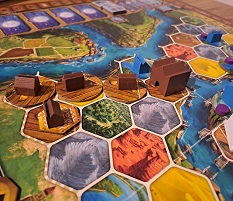This is a review of the latest heavy strategy board game in the Terra Mystica universe. Does it continue the famous lineage? How does Age of Innovation compare to Terra Mystica and Gaia Project?
Introduction
It was a couple of years ago, when I was reviewing Gaia Project, that I first encountered the “Terra Mystica gaming system”. Back then, I had the luxury to judge Gaia Project (GP) coming in fresh, without prior knowledge of Terra Mystica (TM).
This time, I’m afraid this luxury is no more. I have played dozens of games of both GP and TM and can confidently say I know the games pretty well (not that I’m particularly good at them :)). In that respect, this review will rely heavily on my with the two games experience – something I can’t erase. But I’ll try to make myself understood by newcomers, as well.
What is Age of Innovation?
Age of Innovation (AoI) is a strategy game of open information, where players try to adapt their strategy according to the variable setup and scoring goals.
You will lead a fantasy faction and spread it across the map, terraform terrain, and construct and upgrade various buildings along the way. This will increase your intake of resources and allow you to adopt technologies and innovations that will further boost your economy and scoring capabilities.
Of course, there will be competition for the living space along the way, but your neighbors are relatively peaceful. In fact, factions enjoy economic bonuses when close by, so there’s an elusive struggle for balance of having enough room to spread and staying close going on at all times.
Age of Innovation Facts
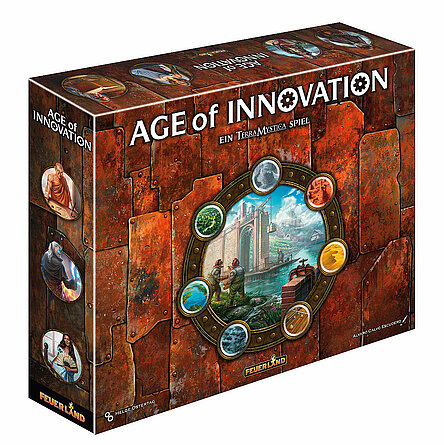
Designer: Helge Ostertag
Artists: Álvaro Calvo Escudero, Lukas Siegmon
Players: 1-5
Playing time: 40 minutes-200 minutes
Complexity: medium-heavy
Basic Principles of Play
The game lasts for six rounds, and every round will offer bonus points for certain actions. For example, 2 points for each workshop built this round, 5 points for founding a town, 2 points for increasing your competency level, and so on.
A round starts with an income phase, where you receive all the exposed resource icons from your board. What follows is the action phase, where players perform actions by spending these resources (and sometimes earn others on the way).
A round ends with round bonuses from the round scoring tile – you can receive certain bonuses depending on how high you are on the four competency tracks. Combined with the round scoring, both bonuses act as an incentive on what to (try) to do each round to do well in AoI.
After the six rounds, there’s the final scoring, which takes into account the total number of your structures on the map and (again) how high you are on the four competency tracks.
Resources
Constructing buildings will expose resource icons on your player mat (these are double-layered this time, yay!): tools, coins, scholars, power cycle tokens, and books. While most are just renamed from TM, the books are new.
They can be best compared to QIC cubes from GP. A very flexible resource that can be used to gain powerful innovation tiles (advanced technologies) or for certain actions. Moreover, there are four different colors of books, and innovation tiles demand a specific combination of five books, requiring a bit of planning.
The power cycle with its three bowls is the trademark of the series and it’s not any different in AoI. It’s a fluent resource that is constantly charging (particularly if someone erects a structure in your vicinity) and can be spent for most other resources or actions. Managing your power cycle is key to success.
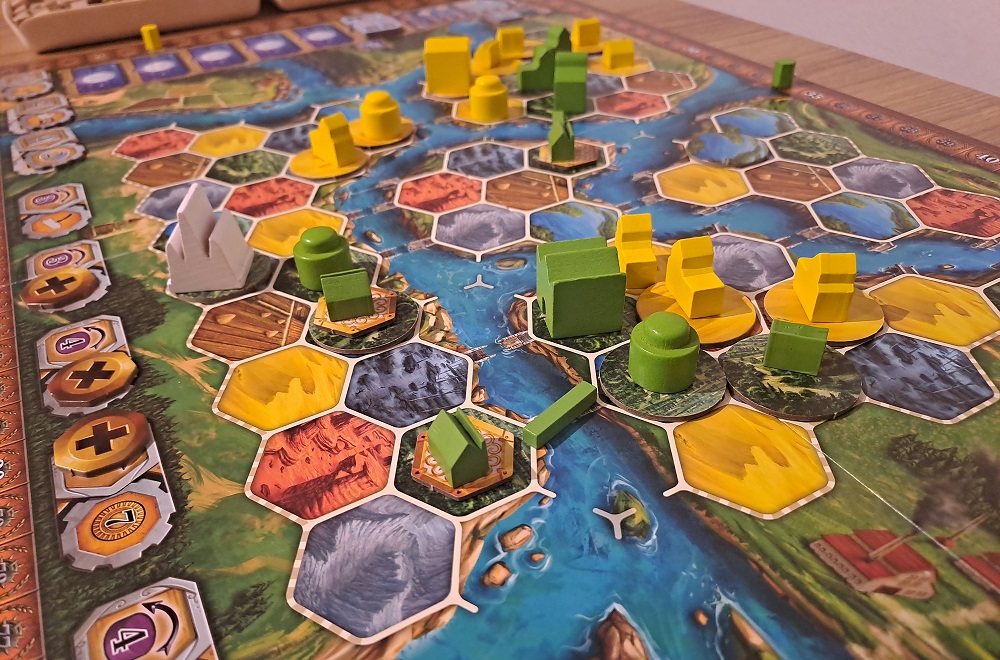
Actions
In the action phase, players continue to perform one action at a time, until everyone passes. This means you can perform as many actions as you can afford per round. Some of the actions are:
Terraform and build: Before you build a workshop, you must change the terrain to your color. This can be done by paying tools or by performing a power action. The further away the terraformed terrain is from your native terrain, the more expensive the terraforming process.
You can upgrade your structures, replacing the old ones with the new ones (after paying costs, of course). You will get the benefit of the new building (income etc.), but the old one is returned to your board, thus making you lose the income benefit from it.
When a cluster of buildings reaches a certain scale, it automatically forms a city, granting immediate bonuses in points and resources of your choice. Furthermore, each city provides a key, which is needed to advance past a certain step on the competency ladder (they now have more steps beyond the unlock).
When upgrading to a school or university, you also get to pick a competency tile. These work just like the favor tiles from TM, giving you immediate or ongoing benefits (resources, scoring opportunities, even neutral buildings). Also, they provide instant advances on the competency tracks and books of their colors. Generally, they are another crucial element you need for victory.
In TM each faction had its own powerful palace (or stronghold, as it was called there) ability, which was unlocked as you upgraded to it. This time, the abilities are not tied to the faction, but you get to choose one from those available on the display.
If you have the right books, you can also take an innovation tile. In general, these are similar to competency tiles, only stronger.
How to score points?
The reason why you’re doing all this spreading on the map, gaining technologies, charging power, and so on, is, of course, to help you with scoring big points. We already mentioned how the end scoring works and how the round scoring works – you want to do your actions in accordance with them.
But during the game, you can also unlock several other ways of scoring. Perhaps you will acquire a competency tile that will give you 2 points each time you construct a workshop on the map border. Or maybe you’ll pick an innovation tile that will allow you to build a neutral university.
There are a lot of options and the inexperienced player can be quickly overwhelmed with all the choices and information around. As you become more experienced, however, you start to see the path through the maze of optimization and that’s when the game opens up.
Components
The box of Ago of Innovation is packed full of quality components. And it’s all old-school cardboard + wood. Exactly what we prefer. Dual player boards, wooden buildings and tokens of various colors, numerous tiles and cards, it all feels great in the hands and looks gorgeous on the table.
Unfortunately, there’s no storage solution (other than plastic bags), which makes handling the components fiddly and lengthy. Since a third-party insert is pretty much mandatory for regular play, the publisher could save us the trouble and include at least some insert.
I’m sure many players would gladly pay more, especially, since Age of Innovation is a product for the “higher-end” of the user base (there’s Terra Nova for more casual players). Or maybe my thinking is completely wrong and they went along the lines “Why bother with an insert that most player will throw out anyway and use their own”.
The bottom line is that there’s no insert and that the game desperately needs one.
Theme
The theme itself is quite “pasted on”. Not that anyone expected a narrative background or a story mode. They’re just fantasy races meeting Renaissance & industrialization. This is sufficient for such a game, especially since the graphical presentation is on a high level.
Experienced players will notice they changed the names of resources, to make them a bit more in accordance with the “innovation” theme. Priests are now scholars, workers are tools, mines are workshops, favor tiles are competent tiles, and so on. While this is in no way detrimental, it can be slightly confusing.
Rulebook
The rulebook is also very good. It starts with the setup, explains the general principles of the game, and then moves on to actions. Finally, all the tiles are included in the appendix, explaining what they do. It’s hard for me to judge how the rulebook is if you’re a newcomer, but everything seems to be in the right place.
But learning Age of Innovation from scratch is not going to be an easy task, make no mistake about that. Your best bet is to play with someone who can teach you. Similar to Gaia Project.
Setup
As you can imagine, it can take a while to set up a game of Age of Innovation. There are just so many components and tiles you need to prepare and it adds up. It gets better as you rack up some experience and a storage solution would definitely help speed up the process, as well.
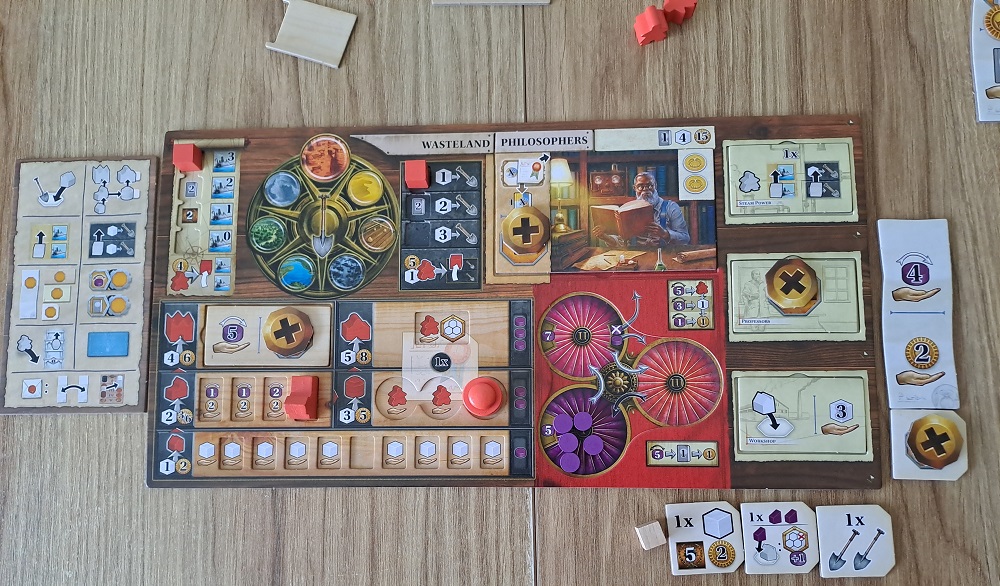
Gameplay Impressions & Comparison to Terra Mystica and Gaia Project
So, how does everything add up when the game is in action? Very good, actually. The gameplay is very similar to both GP and TM (obviously), but Age of Innovation could be best described as a pimped-up Terra Mystica. Very comparable, yet with more customization options.
The new dynamic palace bonuses are an excellent tweak. They help by delaying the crucial faction selection decision which had to previously been made before the start to later. This gives you more time to develop a strategy and choose the ability accordingly. On the other hand, the earlier you build your palace, the more options you will have. But since the pool of abilities is the same for all players, you might run out of useful ones if you wait too long.
New factions are diverse and interesting. Some are similar to the TM factions, some are derivations of them, and some are new. They all come with a special ability and different starting bonuses. The Blessed, for example, always count their competency tracks as if they were three steps higher – for end-of-round bonus purposes. Moles come with the (familiar) burrowing ability, and so on.
Gaia Project Factions and Strategies
There’s definitely a lot to explore and I’m sure they will keep fans busy for years. Especially since the second part of the starting bonus is derived from your terrain – which is now not tied to a specific color, but is randomly drafted, drastically increasing the number of starting combinations.
Becoming Competent
If you remember, in TM you were often shoehorned into what favor tile you should take, as there were quite a few obvious choices. Now, the 12 favor tiles (or competency tiles, as they are now called) are not tied to a certain track but are shuffled, further increasing variety. This gives you a lot more to think about when deciding which one to go for. I’d even say that the tiles themselves are also more interesting and useful than in TM, very similar to GP.
Innovation tiles are a further possibility to customize your faction. Only a few are randomly selected for each game from a larger pool. Their costs (which five books you need) also change from game to game. This forces you to adapt your strategy to what is available, instead of always going for what is optimal for your faction. Innovation tiles are very strong, comparable to advanced technologies in GP.
For example, there are direct scoring innovation tiles (6VP for each bridge), tiles that allow you to build powerful neutral buildings, tiles with strong income (points + scholar), and so on. Some are better to get early, some are late-game scorers.
All Roses and No Thorns?
In the gameplay aspect, it’s hard for me to find anything negative to say about Age of Innovation. It shows that this is the third title in the series and that the core mechanics are as sound as it gets. The layer over them feels different enough from both TM and GP, that it can proudly stand on its own.
The tightness of the map resembles Terra Mystica, while the greater variability in the setup is more akin to GP. This variability, new resources, and the increased option to customize your faction during the game seem to also increase the flexibility of your gameplay. It felt like it was slightly easier to get the economic snowball going and get to those satisfying big turns.
Perhaps the biggest red flag for most people is the overall complexity of the game. Yes, for those of us who have played dozens of TM and GP games before, the flow and strategizing come naturally already. But for someone new to the genre, the first few games will be tough. There’s a lot of information bombarding you from all sides and you’ll have no chance against the more experienced players.
Scalability and Playing Time
Age of Innovation retains the renowned player scalability from its predecessors. The power charging + the upgrade discount works fantastic as a tool to keep the players at exactly the right distance.
Obviously, the dynamic changes a bit with more players (some factions enjoy the closeness more, there’s more competition for everything, people aiming for similar stuff, etc.), but this is just another element of the game’s customization that you have to take into account when making strategic decisions.
With this in mind, there are still two maps to choose from, smaller (1-3 players) and larger (3-5) players.
If we look at how long it takes to play – it depends greatly on the number of players and their competency at a game. A solo or a two-player game with people who know what they’re doing can be over in under an hour (not including setup and teardown), while larger player counts can prolong the event to two or three hours.
But unless you’re playing with players that have an analysis-paralysis problem, the turns usually run pretty swiftly. You can plan your future moves off-turn and the game never feels like a drag.
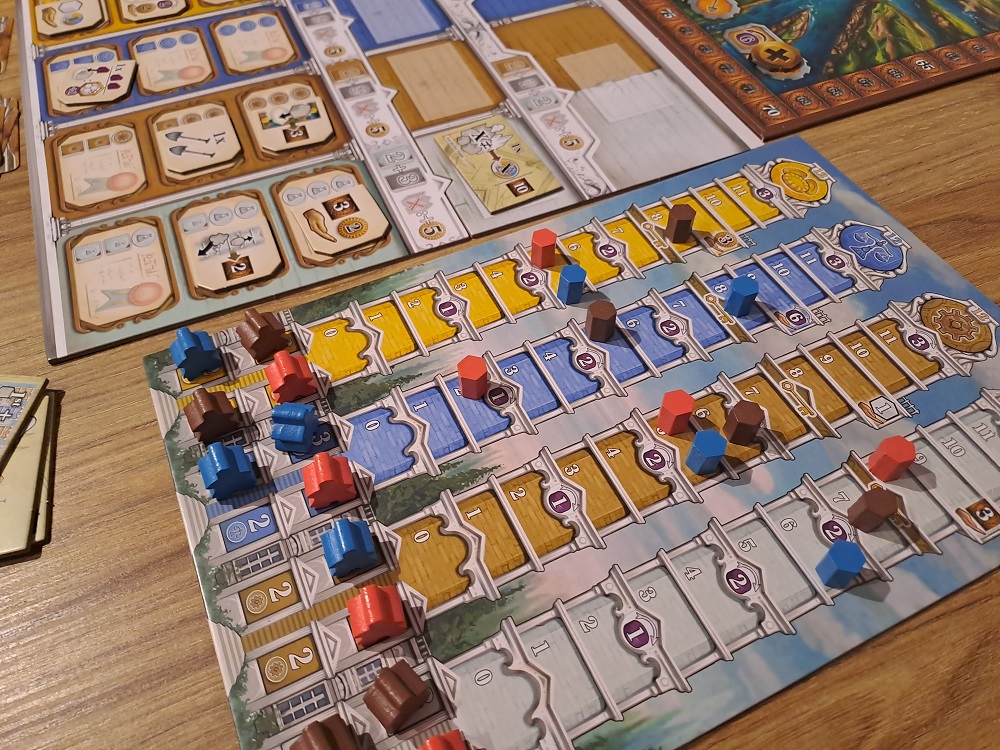
Solo Mode
The solo mode is directly derived from Terra Mystica (which is derived from Gaia Project). It works pretty much the same. You play against an automated opponent, controlled by a deck of cards. It’s a robust and straightforward system, but it does take a while to get used to it, particularly how the build priorities work. But once you have a few games under your belt, it’s very smooth.
Although the opponent never feels human, the system does an excellent job at providing a measurable hurdle and an entity that competes for space and technology tiles like a human adversary would. Moreover, there are several difficulty levels to choose from, as well as numerous automa factions, some designed exclusively for the solo mode.
The only negative is the slightly confusing setup, as you have to refer to two different manuals + the appendix for the 2-player game modifications. I would prefer to have a checklist in one place. Waiting for fan-made stuff. 🙂
So, yeah, the solo mode is pretty much excellent and you can buy Age of Innovation for strictly solo play with no hesitations. With all the setup options, I’m sure fan scenarios (solo challenges) will pop up on BGG soon.
Long Term Appeal
Obviously, only time will tell if Age of Innovation will still be a relevant game a couple of years from now. But what I’ve been able to see in the few games I’ve managed to play, things are looking good.
It took a proven foundation and spiced it up with near-infinite combinations of terrain, faction, palace abilities, competencies, and innovation tiles that will take years to explore.
Although it does not feature a modular map, a static map (or both of them, for that matter) is helped by the fact that your faction is not tied to a color. So this is not a problem in my book, either.
Conclusion
Just like its predecessors, Age of Innovation is a top-notch strategy game. It’s definitely on the more complex side of the spectrum and it can take players a while to get into. But with some enthusiasm, it’s definitely possible. Also, you might look into Terra Nova first.
For experienced players of the genre, this will feel familiar enough that you will be able to get right into it, yet different enough to provide new, fresh challenges. The big question is perhaps whether you really need another similar game in your collection and that’s something only you can answer.
More reviews of heavier games:
Do you like what you just read? Consider subscribing for more content:
